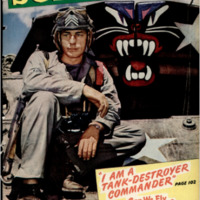Hit Where it Hurts! Tips on Bare-Handed Defense Against Thugs
Item
-
Title (Dublin Core)
-
Hit Where it Hurts! Tips on Bare-Handed Defense Against Thugs
-
Article Title and/or Image Caption (Dublin Core)
-
Hit Where it Hurts! Tips on Bare-Handed Defense Against Thugs
-
extracted text (Extract Text)
-
Jcnussive defense against bodily at-
tack, and skillful offensive tactics
against an unarmed opponent, are easy if
you learn the basic principles taught Amer-
ican Ranger and Raider battalions. The
whole secret lies in disabling the enemy by
locating the main nerve centers in his body
and bringing pressure against them to
cause extreme pain or temporary paralysis.
Of the five natural weapons at any man's
disposal, the most useful is what might be
called the “saber slash.” This deadly blow,
administered with the edge of a stiffened
band, can often knock your opponent out
when applied to the base of the nose, just
below the biceps, just above the wrist, on
the upper forearm, or against the windpipe.
The kidneys and both sides of the trunk, at
about the fifth or sixth ribs, are also vul-
nerable spots for a slashing attack.
The “knuckle bore is a telling substitute
for the saber slash in close-quarter fight-
ing. The weapon in this case is the knuckle
of the middle finger raised to form a wedge
above the fist. The pincers grip—applied
by thrusting a thumb into your enemy's
muscle and pressing downwards against
the fingers—will also cause a sharp, dis-
abling pain at the shoulder, against the
jugular vein, between the collarbone and
the base of the neck, or in the soft spots at
the base of the ear.
If you are attacked and caught from be-
hind, one method of escaping is to-work an
arm free and direct a blow with your elbow
at your attacker's solar plexus, at the
point where the lowest ribs join the breast-
bone. Failing this, you can kick him smartly
on shin or instep, or stamp on his toes,
causing him such sharp pain that he will
relax his hold.
Finally, there is the chin jab, as stagger-
ing as a right to the jaw and easier to de-
liver-—a short, jolting, upward motion of
the cupped hand with the full weight of the
body behind it.
-
Language (Dublin Core)
-
eng
-
Date Issued (Dublin Core)
-
1943-10
-
pages (Bibliographic Ontology)
-
78
-
Rights (Dublin Core)
-
Public Domain (Google digitized)
-
Archived by (Dublin Core)
-
Matteo Ridolfi
-
Alberto Bordignon (Supervisor)
 Popular Science Monthly, v. 143, n. 4, 1943
Popular Science Monthly, v. 143, n. 4, 1943


